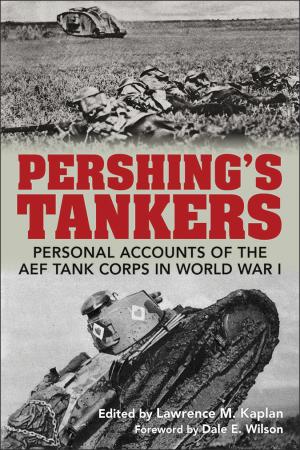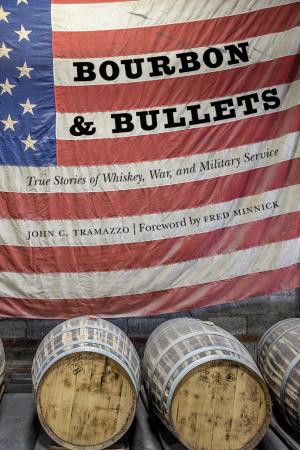March 2019 Book Reviews
March 2019 Book Reviews
Tales of America’s First Armored Soldiers
Pershing’s Tankers: Personal Accounts of the AEF Tank Corps in World War I. Edited by Lawrence M. Kaplan. University Press of Kentucky (An AUSA Title). 312 pages. $50
By Edward G. Lengel
The officers and men of the U.S. Army Tank Corps knew they were making history as they deployed to the Western Front in the late summer of 1918. Although the British and French—and to a lesser extent the Germans—had been experimenting with armored vehicles in combat since 1916, Americans were new to mechanized warfare. Rather than dismiss tanks as aberrations, however, they embraced them enthusiastically as harbingers of the future. The men who built the tank corps and led it into combat tell their stories firsthand in Pershing’s Tankers: Personal Accounts of the AEF Tank Corps in World War I, edited by Lawrence M. Kaplan.
Their fervent desire not just to learn in action, but to record their experiences for the benefit of posterity, ultimately ensured the creation of an effective American armored force in World War II despite two decades of military penury and ignorance in the 1920s and 1930s.
Three tank corps battalions saw combat in World War I: the 301st, 326th and 327th (the latter two eventually redesignated the 344th and 345th, respectively). The 301st employed British Mark V heavy tanks and fought under British command in northern France and Flanders, Belgium, while the other two battalions used French Renault light tanks and served under American command in the St. Mihiel and Meuse-Argonne offensives. Like their allies, American tankers struggled with problems of mechanical unreliability, maintenance and supply. They also improvised tactics in the face of poor terrain, wretched communications, poor interarms coordination and oft-effective enemy countermeasures.
Despite these hindrances, the U.S. Army Tank Corps was far from ineffective. At times, tanks had a decisive tactical impact on the battlefield. At the beginning of the Meuse-Argonne Offensive on Sept. 26, 1918, for example, Renaults of the 304th Tank Brigade under the command of
Col. George S. Patton failed to support the assault effectively because of widespread mechanical failures, bad terrain and poor communications. Instead of punching a hole in the German lines, the tankers became caught up in the collapse of the U.S. 35th Infantry Division, which had to be pulled off the line after a few days. A week later, however, a handful of Renaults that deployed in a surprise counterattack shattered a German assault against the American-held town of Apremont—perhaps the first successful defensive armored deployment in U.S. military history.
Brig. Gen. Samuel D. Rockenbach, commanding the tank corps, recognized the significance of each armored action, whether large or small, successful or unsuccessful. After the war concluded, he directed each of his officers to prepare a capsule memoir of no more than 1,000 words describing his experiences at the front. These were not, Rockenbach said, to be dry professional reports, but “vivid” stories replete with “all possible local color and human interest.” The goal was to educate and inspire future American armored warriors.
These reports form the foundation of this fascinating and valuable collection. Beginning with a concise but informative overview of tank corps history, it continues with a clearly organized series of personal accounts describing the formation, deployment and combat history of this unique unit.
Patton’s account stands foremost given the significance of his role at the time and thereafter, but the accounts of other officers are equally and often more intriguing, and provide broad perspective on combat operations over space and time. Other accounts are taken from reports, diaries, letters and newspapers. Supplemented by useful illustrations, diagrams and appendices, Pershing’s Tankers is a useful primary source and compelling reading.
Edward G. Lengel is an independent military historian. He serves as an adviser to the U.S. World War I Centennial Commission and is the author of Never in Finer Company: The Men of the Great War’s Lost Battalion.
* * *
Veterans’ Vignettes Paint Pictures of Battle
After Combat: True War Stories from Iraq and Afghanistan. Marian Eide and Michael Gibler. University of Nebraska Press. 280 pages. $29.95
By Kelly Kennedy
After being asked to read a book for a community project that he saw as “sensationalized,” Army combat veteran Michael Gibler decided to write an “unvarnished” account of war.
Gibler, a 28-year career infantry officer, worked with Marian Eide, an English professor at Texas A&M University, to tell veterans’ stories in their own words.
In After Combat, the pair hope to allow civilians to better understand combat and to help veterans see that others may feel the same about their experiences: that they may not feel like “real” combat vets; or that they feel brave, ashamed, scared or sad.
Gibler and Eide interviewed more than 30 veterans. They kept their sources anonymous, they said, so the veterans might feel more comfortable talking about their experiences and feelings.
For example, one veteran said, “It was the end of the patrol; I wasn’t paying as much attention as I should have; and I missed the signs that someone was setting up an improvised explosive device. We hit it, and it was my fault.”
But the authors do not set out to tell a story. Instead, the book is a series of transcribed snippets from the interviews categorized into related topics, such as “Enlist/Commission,” “Explosion” and “Struggling.”
Rather than laying out a full narrative from each person, there’s a snippet that could be as long as several pages or as short as a sentence. The snippets are separated by three dots arranged horizontally, but there’s no identifying information or context. For example, one snippet says only this: “I’ve got a bunch of torn cartilage in my knee; I’ve got back problems and all sorts of stuff.”
The reader doesn’t know what happened to that person; if it’s a man or a woman; if it’s an enlisted person or an officer; or how that person was injured. The reader doesn’t know if the person is the platoon jokester; if she grew up in a swamp; or if he was known for his ability to take care of his guys. Anonymity comes at a price: If there’s no story—no knowledge of the person—it’s hard to know how to feel about, or how to relate to, the person who has “back problems and all sorts of stuff.”
In the “Explosion” chapter, we see snippet after snippet about veterans’ first exposure to explosions, in their own words. That can be compelling in places, but it also means “you know” may appear three times in a sentence, because that’s how people talk. One could literally feed an army with the “literallys” strewn throughout the book.
Still, it would be hard to find a veteran who couldn’t open the book to a random page and not feel pulled in, for at least a minute, to the experience of a brother or sister.
Kelly Kennedy is an Army veteran who served in Operation Desert Storm and Mogadishu, Somalia. She is a journalist and the author of They Fought for Each Other: The Triumph and Tragedy of the Hardest Hit Unit in Iraq and the co-author of Fight Like a Girl: The Truth Behind How Female Marines Are Trained.
* * *
Following the Spirited Trail of Soldiering
Bourbon & Bullets: True Stories of Whiskey, War, and Military Service. John C. Tramazzo. Potomac Books. 296 pages. $29.95
By Col. Steve Patarcity, U.S. Army Reserve retired
There are items made in the U.S. that could be called uniquely American. To name a few, John C. Tramazzo, the author of Bourbon & Bullets, points out that the game of baseball fits that definition, as do the bald eagle and apple pie.
Aah … but then there’s bourbon. Positively an American invention, bourbon is regulated by the government, recognized by Congress in 1964 as a “distinctive product of the United States.” To qualify being called “bourbon,” clear rules for production were established: a distillation of at least 51 percent from corn, stored in charred oak containers that impart the distinct color and enhance the flavor, made only in America and at least 80 proof.
Traced back to the Colonial era, this spirit has fueled many a conversation, been used as a key ingredient in a regimental punch or grog bowl, served in innumerable toasts to absent friends and comrades at military social gatherings, and even been used as a medical treatment. Of course, those whiskey-fueled socializations inevitably evoke memories and stories, many of which are eloquently captured by the author.
Tramazzo, an Army officer, has combined his love of bourbon with a collection of stories of veterans throughout American history who are or have been intimately involved with distillation, promotion and consumption of the spirit. The book recounts their role in the history and business not only of the whiskey industry, but also focuses on their service and sacrifice from the Revolution to America’s most recent conflicts in Afghanistan and Iraq.
Tramazzo’s research into their tales is meticulous and thorough, as evidenced by his penchant for detail, an excellent 12-page bibliography and a small collection of illustrations and photographs. Six recipes for bourbon-fueled libations are also included, such as Chatham Artillery Punch, the Light Infantry Cocktail and Gen. George S. Patton’s Armored Diesel.
Tramazzo begins his book by defining the requirements for whiskey to be classified as bourbon, gives a historical overview and then moves quickly into a series of stories recounting the relationship between figures in American military history and the “red likker.” As a re-enactor, the tales of the men on the early frontier of the 1700s were of particular interest to me.
Also of note are the many stories of the men who kept the industry alive during Prohibition, men who supported the World War II effort by producing the alcohol needed for ammunition and other wartime requirements, and those who weathered a second interregnum during the Vietnam War, when bourbon was spurned by the 1960s’ generation as part of the “establishment.” Also enjoyable is the story of Thomas Bulleit, who founded Bulleit Distillery in 1987 after returning from service as a Navy corpsman with a Marine battalion in Vietnam, launching an extraordinarily successful business and one of my favorite bourbons.
Don’t assume, however, that this book is solely about a love affair with alcohol. Whether one imbibes whiskey or not, the uniquely American character of the men about whose service the book is dedicated to rises to the top and resonates with the reader. So, if you’re a bourbon aficionado, pour yourself a finger or two of Maker’s Mark, Blanton’s or whatever—or a Diet Coke if you don’t drink alcohol—and maybe fire up a good cigar. Then settle back for a little history from a different and unique perspective.
Col. Steve Patarcity, U.S. Army Reserve retired, is a civilian strategic planner on the staff of the Office of the Chief of Army Reserve at the Pentagon. He retired in 2010 after 33 years of service in the active Army and Army Reserve, which included military police and armor assignments in the U.S., Kuwait and Iraq.
* * *
Loyalists Try to Undermine Revolutionary Cause
The First Conspiracy: The Secret Plot to Kill George Washington. Brad Meltzer and Josh Mensch. Flatiron Books. 432 pages. $29.99
By John F. Ross
In the early days of the American Revolution, the newly appointed commander of the Continental Army struggled to whip a ragtag group of rowdy irregulars into a force that could defeat the most powerful, disciplined army in the world. That story we know well.
Less well known is that Gen. George Washington fought on another front in the spring and summer of 1776, against a shadowy conspiracy that threatened to take his life and derail the nascent Revolution. In The First Conspiracy, authors Brad Meltzer and Josh Mensch take us on a wild ride into the heart of a loyalist plot designed to neutralize Washington, either by kidnapping or assassination.
It’s a rollicking tale, in part because Meltzer is an established thriller writer (The Escape Artist) who turns his hand to nonfiction history for the first time. The present-tense voice can be unsettling for those used to reading history, but the history itself is solid enough to forgive the oftentimes melodramatic storytelling.
At the heart of the story lies the betrayal of a half-dozen of Washington’s Life Guards, the elite squad of bodyguards the commander hand-selected to guard him around-the-clock. His housekeeper may also have been involved. They turned against Washington and the rebel cause in a carefully orchestrated campaign of bribery by the Royal Governor of New York, William Tryon. It was war, but nonetheless betrayal most vile.
Here the fog of war is revealed in telling detail—not on the battlefield but in the murky world of questionable loyalties. When rumors arose of this nefarious conspiracy, the New York Congress, with Washington’s input, assembled a trio of men to investigate. In short order, they dug up alarming information. Fortunately for the Colonists and the future United States, Washington responded with the kind of “sensitive and discriminating judgment” military theorist Carl von Clausewitz described as critical to seeing through the fog.
With the arrival of the British Army to New York City looming, Washington understood that his authority was held together by threads. Perception was critical: Punishment of a conspirator must come fast and publicly—and close to 20,000 attended the hanging of one of the guilty Life Guards, Thomas Hickey, on June 28, even though he was probably not the ringleader. But justice was served. Washington could now move on to address the other enormous pressures facing him. Eleven days later, a similar large gathering formed, this one organized by Washington for the reading of the newly ratified Declaration of Independence.
In the response to the loyalist plot, the nation’s early intelligence and counterintelligence originated. On the fly, Washington and a cadre of supporters started creating guidelines for conducting investigations, interrogating suspects, maintaining secrecy and integrating military intelligence activities with traditional civilian law enforcement. All of these have become central to counterintelligence work today.
John F. Ross is an author whose books include biographies of Robert Rogers, the inventor of special operations; Eddie Rickenbacker, the World War I flying ace; and most recently, John Wesley Powell, the 19th-century explorer and visionary





